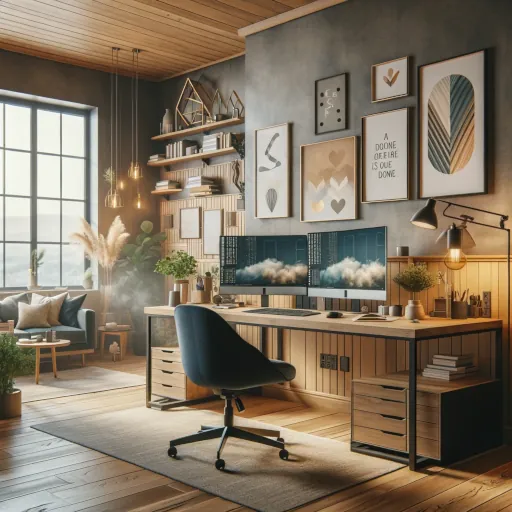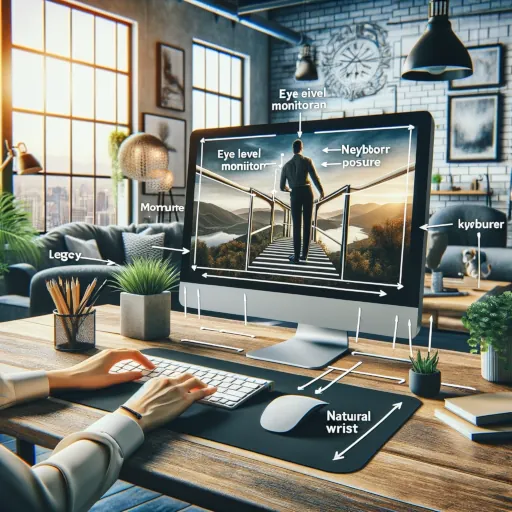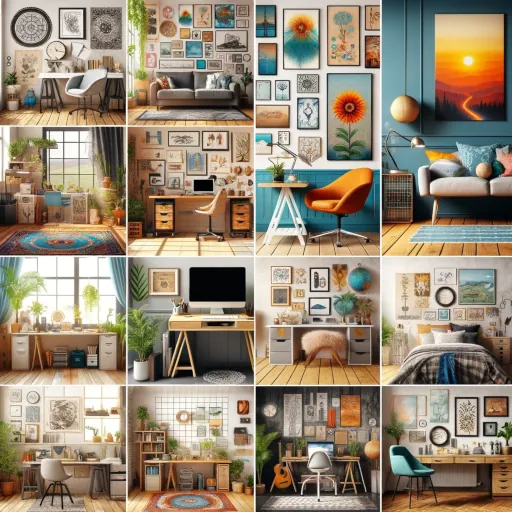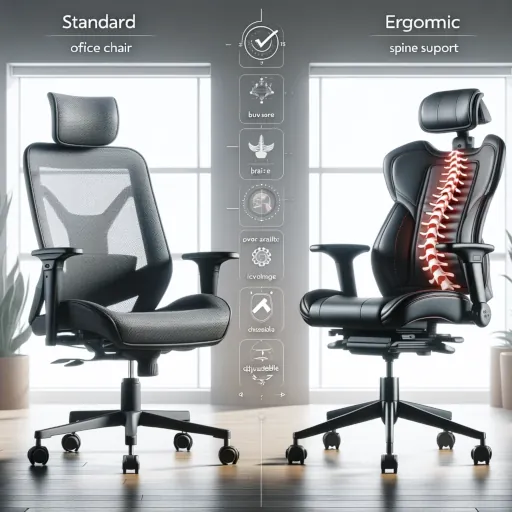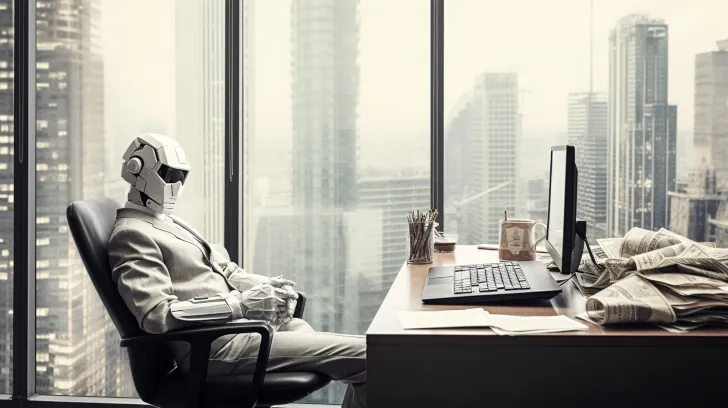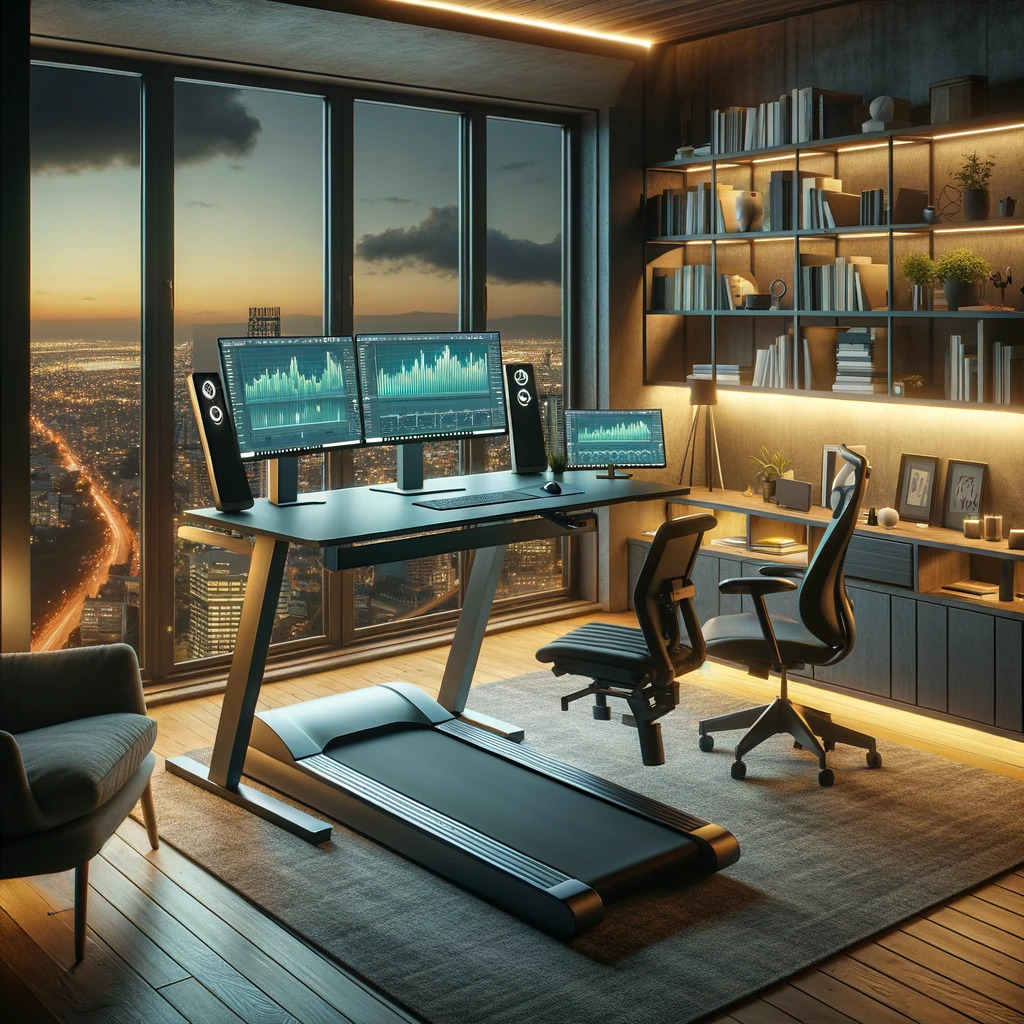Revamp Your Workspace: Top 10 Must-Haves for an Epic Home Office!
1. Ergonomic Essentials: Comfort Meets Productivity
Ergonomics isn’t just a design principle; it’s a necessity for any efficient home office. Here’s how ergonomic design directly impacts your work life:
- Increased Productivity: Studies, like one from Harvard Business Review, show up to a 17% boost in productivity with ergonomic furniture.
- Reduced Health Risks: Proper ergonomics can significantly lower the risk of musculoskeletal disorders.
Key Ergonomic Elements:
- Ergonomic Chair:
- Supports natural spine curvature.
- Adjustable to fit your body.
- Image Suggestion: A side-by-side comparison of a standard vs. ergonomic chair.
- Height-Adjustable Desk:
- Allows switching between sitting and standing.
- Reduces risks from prolonged sitting.
- Image Suggestion: A person using a sit-stand desk in different positions.
- Monitor, Keyboard, and Mouse Setup:
- Monitor at eye level to avoid neck strain.
- Keyboard and mouse positioned for natural wrist posture.
- Image Suggestion: Annotated image showing the ideal setup.
Investing in these ergonomic elements is an investment in your health and efficiency.
2. Lighting the Way: Setting the Mood for Success
Effective lighting is crucial for creating a productive workspace. Consider Sarah’s story: her productivity soared after improving her office lighting.
Why Good Lighting Matters:
- Boosts Mood and Productivity: Bright, natural light keeps you alert and focused.
- Reduces Eye Strain: Proper lighting minimizes the risk of headaches and eye fatigue.
Optimizing Your Office Lighting:
- Maximize Natural Light:
- Position desk near a window.
- Use sheer curtains to diffuse direct sunlight.
- Image Suggestion: A well-lit home office with ample natural light.
- Supplement with Artificial Light:
- Combine overhead and task lighting for balanced illumination.
- Image Suggestion: A diagram showing effective placement of overhead and task lights.
- Choose the Right Bulbs:
- LED bulbs with a color temperature of 4000K to 5000K.
- Imitates natural light, ideal for focus.
- Image Suggestion: Comparison of different bulb types and their light output.
3. Tech Savvy: The Latest Gadgets to Boost Your Efficiency
In the digital age, your home office needs to be equipped with the right technology. Here’s how the latest gadgets can make a world of difference:
- Enhanced Connectivity: High-speed internet and Wi-Fi extenders ensure you’re always connected.
- Productivity Boosters: Tools like dual monitors and advanced software can streamline your workflow.
Key Tech Gadgets:
- Smart Assistant:
- Helps with scheduling, reminders, and hands-free queries.
- Image Suggestion: A smart assistant device in a home office setting.
- High-Quality Headphones:
- Noise-cancelling for focus.
- Wireless for mobility.
- Image Suggestion: Different types of headphones suitable for office work.
- Document Scanner:
- For easy digitization of physical documents.
- Image Suggestion: A modern, compact document scanner.
Investing in these tech gadgets can significantly enhance your efficiency and adaptability in your home office.
4. Color Psychology: Using Hues to Enhance Creativity and Focus
The colors of your home office can significantly affect your mood and productivity. Here’s what you need to know:
- Influence on Mood: Different colors evoke different emotions and levels of energy.
- Impact on Focus: Certain hues can increase concentration and reduce fatigue.
Choosing the Right Colors:
- Blue: Promotes calmness and improved focus.
- Green: Ideal for long hours of work, reduces eye strain.
- Yellow: Stimulates creativity and positivity.
- Neutral Tones: For a calming and minimalist environment.
Implementing Color Psychology:
- Accent Walls:
- Use a bold color for one wall to create focus.
- Image Suggestion: A home office with a creatively painted accent wall.
- Decor and Accessories:
- Add pops of color through office supplies and decor.
- Image Suggestion: A workspace with colorful accessories.
- Natural Elements:
- Incorporate plant life for greenery and a natural feel.
- Image Suggestion: A desk with plants and natural decor elements.
5. Space-Saving Solutions: Maximizing Your Home Office Area
In smaller homes or apartments, space is a premium commodity. But with a few clever tricks, you can transform even the tiniest nook into a functional and stylish workspace.
- Utilize Vertical Space: Think shelves and wall-mounted desks. They take up less floor space and can keep your office essentials within easy reach.
- Multi-functional Furniture: Invest in furniture that serves multiple purposes, like a desk that can double as a dining table, or a storage ottoman for seating and storing office supplies.
- Declutter Regularly: Keeping your space clutter-free is not just about aesthetics; it’s essential for mental clarity. Adopt a minimalist approach and regularly assess what you need.
- Cable Management Solutions: Keep cables organized and out of sight with cable organizers or clips. This small step can make a big difference in making your space look neat and spacious.
- Creative Storage Solutions: Use under-desk baskets, wall organizers, or even pegboards to keep your office supplies organized yet accessible.
- Foldable or Retractable Elements: Consider furniture that can be folded away when not in use, like foldable chairs or retractable desks.
Image Suggestion: A photo of a small home office space creatively utilizing vertical space and multifunctional furniture.
6. The Power of Plants: Bringing Nature Indoors
Introducing greenery into your home office can have a surprising impact on your work environment. Plants not only add a pop of color and life to your workspace but also come with several health benefits.
- Air Purification: Certain plants, like the snake plant or spider plant, are known for their air-purifying qualities, removing toxins and improving air quality.
- Stress Reduction: Studies have shown that having plants in your workspace can reduce stress and increase feelings of well-being.
- Enhanced Creativity: Greenery can boost creativity. A view of nature or even just a few plants on your desk can lead to more innovative thinking.
- Noise Reduction: Plants can act as natural sound absorbers, making your workspace quieter and more serene.
7. Personal Touch: Infusing Your Personality into Your Workspace
Your home office is a reflection of your unique style and personality. Here’s how personalizing your space can boost motivation and creativity:
- Reflects Your Personality: Incorporate items that reflect your interests and values.
- Inspires Creativity: Personal items can serve as a source of inspiration during your workday.
- Enhances Comfort: Familiar and personal items can make your workspace more comfortable and inviting.
Bringing Personality to Your Workspace:
- Display Artwork or Photographs: Choose pieces that inspire or hold personal significance.
- Use Colorful Accessories: Add pops of color with stationery, rugs, or curtains that resonate with your personal style.
- Incorporate Plants or Books: These can add life and character to your office.
- Create a Theme: Whether it’s travel, vintage, or minimalistic, a thematic approach can unify your workspace design.
Image Suggestion:
- A collage showcasing various personalized home office setups, demonstrating different themes and personal touches.
8. Organizational Hacks: Keeping Clutter at Bay
An organized workspace is key to efficiency. Here are some organizational hacks to keep your home office clutter-free:
- Reduces Stress: A tidy workspace can minimize stress and mental clutter.
- Saves Time: Good organization means less time spent searching for things.
- Boosts Productivity: A clutter-free environment enhances focus and productivity.
Tips for an Organized Workspace:
- Use Shelving and Storage Solutions: Invest in bookshelves, drawers, or wall organizers.
- Cable Management: Use cable ties or clips to keep cords neat and out of sight.
- Label and Categorize: Clearly label storage to easily locate items.
- Regular Decluttering: Set a schedule for regular cleaning and decluttering of your workspace.
9. Sound Strategies: Managing Noise in Your Home Office
Noise can be a significant distraction in a home office, impacting concentration and productivity. Here’s how to create a more acoustically pleasant environment:
- Identify Noise Sources: Start by identifying the primary sources of noise in your space. It could be external (traffic, neighbors) or internal (home appliances, family activities).
- Soundproofing Solutions: Consider soundproofing options like acoustic panels, window inserts, or heavy curtains. These can significantly reduce external noise intrusion.
- Quality Headphones: Invest in noise-canceling headphones for an immediate solution to cut down on background noise.
- Soft Furnishings: Carpets, rugs, and soft furniture can absorb sound and reduce echo in the room.
- Sound Masking: Ambient noise machines or soft background music can mask distracting sounds.
- Image Suggestion: A diagram showing soundproofing techniques in a home office, such as the placement of acoustic panels and use of heavy curtains.
10. Comfort and Style: Balancing Aesthetics and Functionality
Your home office should be a reflection of your personal style while remaining functional. Here’s how to strike that balance:
- Personalize with Decor: Add personal touches like artwork, photos, or plants to make the space uniquely yours.
- Choose a Theme or Color Scheme: A cohesive theme or color scheme can tie the room together aesthetically.
- Functional Furniture: Choose furniture that is not only stylish but also serves your work needs – like a bookshelf that doubles as a decorative piece.
- Ergonomic Accessories: Don’t sacrifice comfort for style. Ergonomic accessories can be both functional and fit your aesthetic.
- Lighting as a Design Element: Use lighting fixtures not just for illumination but also as style elements.
- Multipurpose Spaces: If your office is part of a larger room, use design elements to define the workspace while maintaining the room’s overall flow.
- Image Suggestion: A collage of home office spaces showcasing different themes and color schemes, highlighting how personal style and functionality can be merged.
Rebéka (fit_beka) ist Sportlerin und Unternehmerin im Bereich Gesundheit. Sie war auch schon Body Builderin und hat als Personal Trainerin gearbeitet.
Nach vielen Jahren im Office und im Außendienst arbeitet sie nun viel im Homeoffice und ist mittlerweile eine Expertin im Bereich Ernährung, Körpertraining und im Thema exogene Ketone.
Hier geht es zu ihrem Linkprofil: https://linktr.ee/Fit_Beka
Am aktivsten ist sie derzeit auf Instagram und TikTok

